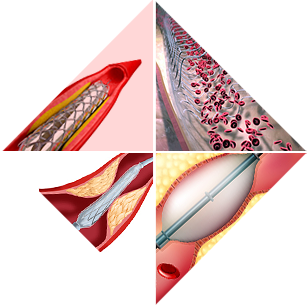
Coronary Angioplasty
Asia Med Care has collaborated with several hospitals in India for the best possible cardiac treatment with a team of highly trained and experienced cardiologists and Cardio-thoracic surgeons to ensure world class treatment, providing a rejuvenating and healing experience improving the lives of cardiac patients.
Coronary Angioplasty
Coronary angioplasty is accomplished using a balloon-tipped
catheter inserted through an artery in the groin or arm to
enlarge a narrowing in a coronary artery. Angioplasty is
successful in opening coronary arteries in well over 90% of
patients. Up to 30% to 40% of patients with successful
coronary angioplasty will develop recurrent narrowing at the
site of balloon inflation. The use of newer devices such as
intracoronary stents and atherectomy, as well as newer
pharmacologic agents has resulted in higher success rates,
reduced complications, and reduced recurrence after
percutaneous coronary intervention. Angioplasty physically
opens the channel of diseased arterial segments (see below),
relieves the recurrence of chest pain, increases the quality
of life and reduces other complications of the disease.
The Surgery
Coronary angioplasty of the coronary artery, or percutaneous
transluminal coronary angioplasty (PTCA), is a non-surgical
procedure that relieves narrowing and obstruction of the
arteries to the muscle of the heart (coronary arteries). This
allows more blood and oxygen to be delivered to the heart
muscle. PTCA is now referred to as percutaneous coronary
intervention, or PCI, as this term includes the use of
balloons, stents, and atherectomy devices. Percutaneous
coronary intervention is accomplished with a small balloon
catheter inserted into an artery in the groin or arm, and
advanced to the narrowing in the coronary artery. The balloon
is then inflated to enlarge the narrowing in the artery. When
successful, percutaneous coronary intervention can relieve
chest pain of angina, improve the prognosis of individuals
with unstable angina, and minimize or stop a heart attack
without having the patient undergo open heart coronary artery
bypass graft (CABG) surgery.
Risks:
- Allergic reaction to the x-ray dye
- Bleeding in area where the catheter was inserted
- Blockage of blood flow to an area of the heart (very rare).
- Reduce the risk of death in some patients
- Damage to a heart valve or blood vessel
- Bleeding
- Infection
Complication
- Reaction to contrast dye
- Kidney problems
- Damage to the lining of the artery (called dissection)
- Reduce the risk of death in some patients
- Blockages developing in arteries downstream from the treated artery from particles of the plaque breaking free (called embolization).
Approximate cost for Medical Procedure – 10,300 USD

